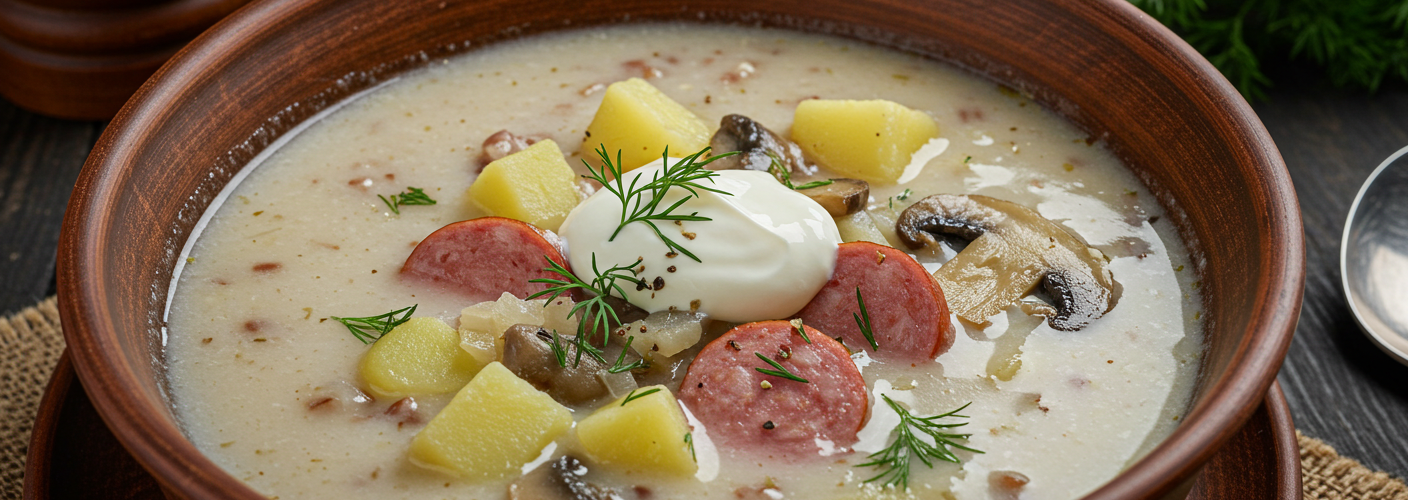Zurek, a traditional Polish sour bread soup, holds a special place in the hearts and kitchens of many Eastern European families. This flavorful dish is not only a culinary delight but also a cultural icon, steeped in history and tradition. Known for its unique tanginess and hearty ingredients, Zurek offers a taste of Poland that is both comforting and satisfying.
Origins and History
The origins of Zurek date back to the Middle Ages when sour rye bread was a staple in the diets of rural communities. The soup’s signature sourness comes from fermented rye flour, which is an essential component in its preparation. Historically, Zurek was a peasant dish, made from readily available ingredients, but over time, it has become a staple in Polish households, especially during traditional celebrations and holidays.
In many families, Zurek might be served during Easter, often paired with hard-boiled eggs and sausage. However, its popularity extends beyond festive occasions, making it a favorite comfort food year-round. The dish is loved not only for its taste but also for its warming qualities, making it perfect for the colder months.
Ingredients and Preparation
The key ingredient in Zurek is the sour rye starter, known as “zakwas,” which is made by fermenting rye flour with water and a few slices of bread for several days. This mixture develops a distinctive sour flavor that defines the soup. The basic Zurek recipe typically includes ingredients such as:
- Rye Flour: Provides the essential sourness and thickens the soup.
- Water: Serves as the base for the soup.
- Vegetables: Carrots, potatoes, and onions add depth and sweetness to the flavor profile.
- Sausage: Smoked kielbasa (Polish sausage) is commonly used, infusing the soup with a rich, meaty essence.
- Eggs: Hard-boiled eggs are often added just before serving for a creamy, satisfying finish.
To prepare Zurek, the first step is to make the zakwas a few days in advance. Once the sour starter is ready, the soup is made by simmering the vegetables and sausage in water. The zakwas is then added, along with seasoning, to achieve the desired level of sourness. The soup is typically garnished with fresh herbs, such as parsley or dill, to enhance its flavor and presentation.
Serving Suggestions
Zurek is often served in a traditional bread bowl, allowing the bread to absorb the delicious soup. This method not only adds flavor but also eliminates the need for additional dishware, making the dining experience more rustic and authentic. When garnished with a sprinkle of fresh herbs and a side of crusty bread, it becomes a feast for the senses.
Pairing Zurek with a glass of Polish beer or kvass can elevate the experience, allowing for a fusion of flavors that resonate with the heart of Polish cuisine. For those looking to explore vegan or vegetarian options, adaptations can easily be made by substituting meat with smoked mushrooms and omitting the eggs, still maintaining the soul of this traditional dish.
Conclusion
Zurek is more than just a soup; it is a culinary journey that reflects the culture and history of Poland. With its rich flavors, heartwarming qualities, and humble origins, Zurek continues to be cherished by many. Whether enjoyed at home or in a restaurant, this sour bread soup is a testament to the enduring legacy of Polish cuisine, inviting all to experience its unique taste and warmth.




Add comment